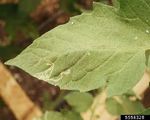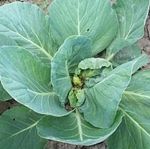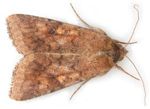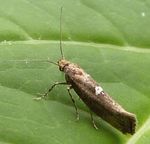SILVER Y MOTH - Maine.gov
←
→
Page content transcription
If your browser does not render page correctly, please read the page content below
Maine Department of Agriculture, Conservation and Forestry
2020 Cooperative Agricultural Pest Survey (CAPS) Program If interested in participating,
Exotic Vegetable Pest Survey contact: karen.l.coluzzi@maine.gov
SILVER Y MOTH
Originally from the United Kingdom, the Silver Y moth has steadily spread across the
globe. The caterpillars feed on plants that grow low to the ground, most often potatoes,
brassicas, lettuce, grapevine, and other common row crops. The Silver Y Moth is a
migratory species and adults undertake seasonal migrations to areas where they are
able to breed. In areas where they can overwinter, severe infestations may occur.
Female moths lay their eggs on the underside of leaves of low-growing host plants.
Emerging larvae feed on the plant's leaves, often consuming the entire plant. Leaves
may be skeletonized by young larvae, leaving plants with a brownish appearance. Older larvae eat from the edge of the leaf towards
the midrib, consuming the leaves completely or at times leaving pieces of the midrib.
Adult moths look like soybean looper. Pheromone traps will be used in corn to help detect the adult stage of this pest.
For more information: http://pest.ceris.purdue.edu/pest.php?code=ITBCFCA
LEEK MOTH Acrolepiopsis assectella
The leek moth is widespread in Europe, is present in Asia and Canada,
and has been found in a number of northeastern states, including
Maine.
Leek moth prefers leek, but it has been known to attack onion, garlic,
chives, and shallots. Females lay eggs on the surface of the plant’s
leaves, and the caterpillar chews into the leaf’s surface. Once in the
leaf, the larvae and the pupae spend their lives mining between the
dermal layers of the leaf, emerging as a mature adult moth. There can be as many as three generations per year.
Adults are gray to brown with a forward-pointing white triangle centrally located on the outer wings. Inner wings are gray.
Pheromone traps will be used in Allium spp. to detect presence of this pest.
For more information: http://web.entomology.cornell.edu/shelton/leek-moth/
CABBAGE MOTH Mamestra brassicae
The cabbage moth is a highly polyphagous pest in Europe and Asia, where it has
been reported feeding on more than 70 plant species. Cabbage moth larvae prefer
Brassica spp. but other reported hosts include apple, beetroot, onion, potato,
rhubarb, tomato, and tobacco.
In cabbage, young larvae feed on the outermost leaves. The older larvae tunnel
into the crown. Larvae are active at night and often curl up when disturbed. Large
infestations can cause significant product loss, although this is usually due to
secondary fungal and bacterial infections, and aesthetic damage resulting from
large amounts of frass production.
Monitoring for this pest involves targeting the adult stage with pheromone traps in Brassica crops throughout the growing season.
Unusual crop damage or evidence of the pest should be reported.
For more information: https://pest.ceris.purdue.edu/pest.php?code=ITBCDMA
SWEDE MIDGE Contarinia nasturtii
The Swede midge is a serious insect pest of cruciferous plants such as cabbage, cauliflower,
and broccoli. It is native to Europe and southwestern Asia, and was first discovered in the
U.S. in Niagara County, NY in 2004. It has since spread to most of New England, although it
has not been detected yet in Maine.
Adult midges emerge from overwintering pupae continually between May and October,
ensuring a constant battle with management. Eggs are laid primarily on the newest growth
points of host plants. Larvae hatch within a few days and begin to feed on plant tissues.
Typical damage includes puckered leaves, swollen petioles, brown scarring at the growing point, and distorted growth points. This
damage is often caused by other factors like mechanical injury, herbicide injury, nutrient deficiency, etc., so is difficult to distinguish.
Monitoring for this insect includes the use of pheromone traps, and hand lenses to look for tiny larvae in the plant tissue.
For more information: http://web.entomology.cornell.edu/shelton/swede-midge/index.htmlGOLDEN TWIN SPOT MOTH Chrysodeixis chalcites
Also known as the tomato looper, the golden twin spot moth is
native to the Mediterranean region and northern Africa, but
occurs in Europe through migration and as a greenhouse pest. It
was recently found in Ontario, Canada. Preferred host plants
include tomato, potato, green beans, and soybean, though it is
known to feed on a wide variety of fruit, vegetable, and
ornamental crops.
In its native region, the moth usually has 6 generations a year, and adult moths can be observed year-round. Eggs are laid in small
clusters in various locations and may be well distributed throughout a crop. Larvae feed on leaves and fruit of their host plants.
Damage symptoms include skeletonized or rolled leaves with webbing. Based on its native distribution and migratory behavior, it
would likely find suitable climate for establishment in Plant Hardiness Zones 6 to 11 of the U.S. and may migrate farther north
during the spring and summer. Pheromone traps in tomato will be used to detect presence of this pest.
For more information: https://pest.ceris.purdue.edu/pest.php?code=ITBCQGA
TOMATO LEAF MINER Tuta absoluta
Native to Peru, the tomato leafminer moth is widespread in South
America, and has been found in Central and North America, as well as
Africa, Europe, & Asia (including Japan).
While tomato plants are the preferred host, this leafminer has also been
observed on other plants of the Solanaceae family, including potato.
Eggs laid on the leaves or base of the host emit caterpillars that burrow
into leaves and mine the plant between the outer dermal layers.
Tomato leafminers will also eat the tomato fruit, causing some specimens to be pink while the leaf-eating caterpillars are greener.
Those which pupate within the leaves do not build cocoons, but those that leave the host and land on the outside or in the ground
do.
The adult has mottled gray/black/brown wings with silvery scales, are about 10 mm long, have filiform antennae.
Pheromone traps in tomato will be used to detect presence of this pest.
For more information: https://pest.ceris.purdue.edu/pest.php?code=ITAMCLA
COTTON CUTWORM
The cotton cutworm is native to Asia, Europe, Africa and the
Middle East, where it goes by a number of different names –
cotton leafworm, tobacco cutworm, tomato caterpillar, as well as
others. Although it has been intercepted at U.S. ports, there is no
evidence of it becoming established.
The cotton cutworm has a broad host range. Major crops
attacked include corn, rice, soybean, cucurbits, potato, tomato,
as well as grape and strawberry. Damage is due primarily to
defoliation by the caterpillar, but cutworm-like damage also occurs on seedlings. Both species feed on the undersides of leaves
causing feeding scars and skeletonization of leaves. Larvae also mine into young shoots causing the tips to wilt. Adults look
similar to fall armyworm.
Pheromone traps in corn will be used to detect presence of this pest.
For more information: http://pest.ceris.purdue.edu/pest.php?code=ITBCFMA
OLD WORLD BOLLWORM
The old world bollworm (OWB) is native to Asia and is now well established in Africa, Australia, and most
of southern Europe. It is not established in the U.S., although it has been intercepted at many U.S. ports
over the years. OWB is genetically and morphologically similar to the corn earworm (Helicoverpa zea).
The host range of OWB is extremely broad, and includes a wide variety of fruits, vegetables, woody
ornamentals, grains, weeds, and flowers. Significant economic loss has been reported on cotton, tomato,
corn, pigeon pea, and other high value crops. Because of its status as a pest of a number of crops, it has
many common names, e.g. cotton bollworm, African bollworm, scarce bordered straw worm, and tomato
worm. Damage is caused by larval feeding on leaves, shoots, flowers, and fruits. Monitoring for this pest
in corn involves targeting the adult stage with pheromone traps at the beginning of the growing season.
For more information: http://pest.ceris.purdue.edu/pest.php?code=ITBCFBAWESTERN BEAN CUTWORM
The western bean cutworm is a late season pest of corn (field, sweet, and popcorn), as well as dry
and snap beans. It is native to North America but has recently expanded eastward from the Great
Plains region. It was detected in Maine in 2012.
Moth emergence peaks around mid-July, when male moths can be monitored using pheromone
traps. Female moths will mate and lay eggs during July and August and will oviposit on a variety of
cultivated and wild plants, although dryland beans and field corn are the most commonly chosen
oviposition sites. Cornfields in the late whorl stage are preferred by female moths, who are
seeking to lay eggs on corn that is near (but not past) pollination. Damage is done to developing
kernels in husks, or beans in pods, by feeding larvae.
For more information: https://extension.entm.purdue.edu/fieldcropsipm/insects/western-bean-cutworm.php
Photo Credits:
Silver Y moth: Adult: Julieta Brambila, USDA APHIS PPQ, Bugwood.org. Larva: Charles Olsen, USDA APHIS PPQ, Bugwood.org.
Leek moth: Adult: Graham Calow, naturespot.org.UK. Larva: OnVegetables, https://onvegetables.com/2013/06/04/leek-moth-update-4-june-2013
Cabbage moth: Adult. Photo © matthew casey, https://www.norfolkmoths.co.uk/?bf=21540. Larva. Steve Ogden, http://www.wildlifeinsight.com/british-
moths/cabbage-moth-mamestra-brassicae/
Swede midge: Adult. Susan Ellis, USDA APHIS PPQ, Bugwood.org. Damage. Julie Kikkert, Cornell Cooperative Extension, Bugwood.org;
Golden twin spot moth: Adult. Perry Hampson, Bugwood.org. Larva. Steve Hatch, Bugwood.org;
Tomato leafminer: Adult. Patrick Clement, www.tutaabsoluta.com. Damage. Pete Nelson, North Carolina State University, Bugwood.org
Cotton cutworm: Adult and larva: Merle Shepard, Gerald R.Carner, and P.A.C Ooi (U.S.), Bugwood.org
Old world bollworm: Chris Lewis ©2011 http://britishlepidoptera.weebly.com
Western bean cutworm: Marlin E. Rice, Department of Entomology, Iowa State UniversityYou can also read



























































